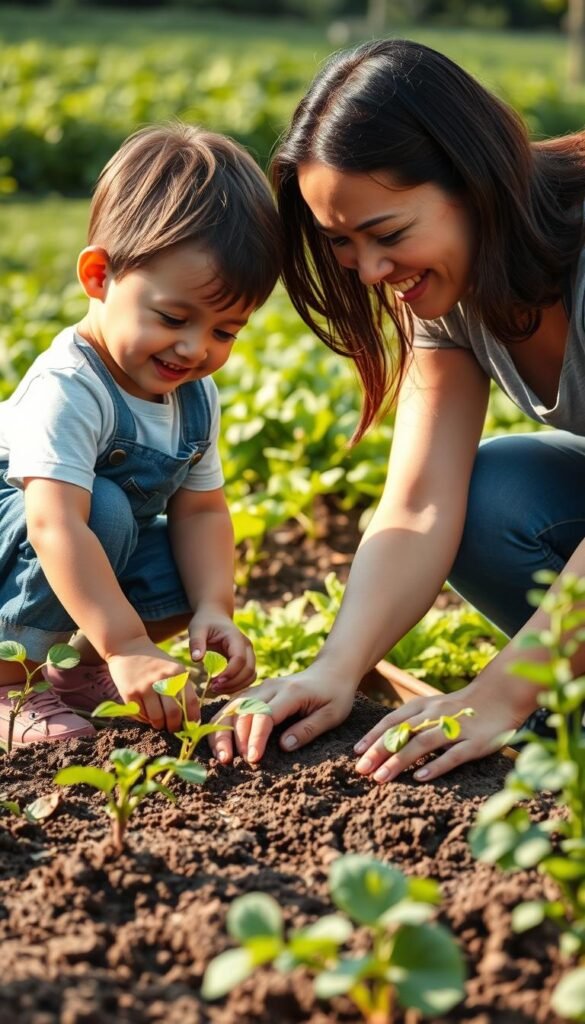Ever watched a seedling sprout after weeks of care? That quiet miracle mirrors what happens when you involve young ones in nurturing plants. This guide explores how tending green spaces builds patience and responsibility in children—no matter your living situation.
From apartment balconies to suburban yards, every patch of soil becomes a classroom. Studies show hands-on activities like watering herbs or tracking growth timelines help kids grasp delayed gratification. Horticulturist David Scott May notes: “When children see their efforts bloom, they internalize cause and effect.”
You’ll discover practical methods to turn routine tasks into engaging lessons. We’ll share age-appropriate projects, from starting seed journals to planning seasonal harvests. Each step reinforces accountability while fostering curiosity about ecosystems.
Expect real-world examples that make skill-building feel like playtime. Whether measuring rainfall for tomato plants or composting kitchen scraps, these activities create lasting connections to nature. Let’s dig into strategies that grow both plants and character!
Gardening with Kids: Simple Ways to Teach Patience & Responsibility – A Path to Life Skills

What if dirt under fingernails could spark lifelong lessons? Working side-by-side in green spaces lets your family cultivate more than basil or sunflowers. Research shows shared outdoor activities strengthen bonds while teaching practical skills like problem-solving and teamwork.
Letting children make choices—like picking seeds or arranging pots—creates ownership. “Young minds grasp cause-and-effect faster when they see their decisions impact growth,” notes educator Maria Lopez. A wilting strawberry plant becomes a gentle lesson in consistency, not failure.
Container gardens offer perfect starter projects. Try growing herbs in recycled jars or salad greens in window boxes. These small wins build confidence and show how daily care leads to tasty results. Even toddlers can pat soil around seedlings or count emerging leaves.
Through this process, your crew learns to celebrate gradual progress. Waiting for sprouts teaches delayed gratification better than any lecture. Up next: actionable strategies to turn these moments into lasting habits. You’ll discover how simple tasks become tools for nurturing resilient, curious humans.
Teaching Patience Through the Garden

Gardens make excellent patience coaches. A carrot seed takes 70 days to mature, while sunflowers burst from soil in 7 days. This natural contrast creates perfect opportunities to teach kids that good things take time.
Mix quick-sprouting plants like nasturtiums with slower growers. Fast results keep young minds engaged, while delayed harvests show the value of consistency. “Quick wins build excitement, but waiting for tomatoes teaches resilience,” explains school garden coordinator Lisa Tanaka.
| Plant | Germination Time | Harvest Ready |
|---|---|---|
| Sunflower | 7-10 days | 60-75 days |
| Carrot | 14-21 days | 70-80 days |
| Radish | 3-6 days | 25-30 days |
Start a growth journal to make progress visible. Let children draw weekly changes or measure stems. These activities turn waiting into discovery rather than frustration.
Three tips for success:
- Plant both fast and slow seeds side-by-side
- Celebrate each growth stage (first leaf, flower bud)
- Use a calendar to countdown harvest days
Through these family gardening activities, you help young growers understand that growth—in gardens and life—requires steady care. Every watered seed becomes a hands-on lesson in nurturing potential.
Fostering Mindfulness and Kindness in Your Garden

What if mud pies could teach emotional intelligence? Gardens engage all five senses, creating natural opportunities for kids to practice mindfulness. When your child crumbles soil between their fingers or inhales mint leaves, they’re learning to focus on the present moment.
- Blindfolded herb identification using smell and touch
- Listening sessions for buzzing bees or rustling leaves
- Texture hunts to find smooth stones or fuzzy lamb’s ear plants
These exercises help children notice details they’d usually overlook. A study by the University of Illinois found that regular sensory engagement with nature increases empathy toward living things. Your little one might start gently relocating earthworms instead of squealing at them!
Even messy tasks like digging in dirt become grounding rituals. Let them feel cool soil under their nails while planting marigolds—it’s therapy disguised as chores. This hands-on connection builds a sense of stewardship, showing how care translates to thriving ecosystems.
By teaching mindful observation, you’re planting seeds of compassion. A “why do flowers need water?” conversation during watering time can spark lifelong respect for nature. Avoid common pitfalls when planning a small-space garden to keep these moments stress-free and joyful.
Building Responsibility and Promoting Hard Work

Every drop from a watering can nurtures more than plants—it grows accountability. Assigning clear tasks like weeding or turning compost gives children measurable ways to contribute. Research shows kids who care for living things develop 23% stronger task commitment compared to peers.
Start with bite-sized duties matching their abilities. A 4-year-old can water herbs with a small jug, while teens might manage pest control. “Defined roles help young helpers see their impact,” explains youth program director Amy Kessler. Celebrate when seedlings thrive under their watch—it turns chores into earned pride.
| Age Group | Task Examples | Skills Developed |
|---|---|---|
| 3-5 years | Seed planting, leaf counting | Following instructions |
| 6-8 years | Watering schedule, measuring growth | Consistency |
| 9+ years | Compost mixing, harvest planning | Project management |
Container gardens offer perfect starter opportunities. Watching basil flourish through their daily work teaches cause and effect better than any app. When aphids attack or storms hit, guide them through problem-solving rather than fixing it yourself.
Three keys to success:
- Match tasks to motor skills (tiny hands handle big seeds best)
- Use visual checklists for watering days
- Share harvests—salsa from their tomatoes tastes like victory
This hands-on hard work pays dividends beyond ripe veggies. Young growers learn that responsibility means showing up even when bugs bite or rain soaks their shoes. Those muddy knees? They’re building calluses for life’s tougher challenges.
Boosting Self-Esteem with Garden Successes

Nothing shouts “I did it!” like a sunflower reaching for the sky. When children learn their care directly impacts living plants, every sprout becomes a confidence booster. Studies reveal kids who witness garden results show 40% higher persistence in challenging tasks compared to peers.
Celebrate small victories—a cherry tomato turning red or a marigold unfurling petals. These visible benefits prove effort creates change. “Completing a weeding job or pruning task gives them proof of their capabilities,” notes child psychologist Dr. Elena Torres. Even failed attempts become teachable moments when framed as stepping stones.
Try these ideas to magnify achievements:
- Create a life-cycle scrapbook with photos from seed to harvest
- Host monthly “garden tours” where kids showcase their thriving greens
- Let them gift herbs to neighbors—pride grows when others appreciate their work
Tracking progress makes growth tangible. A simple chart comparing basil heights week-to-week reveals hidden patterns. Over time, these experiences shape how young minds approach life’s challenges. They start seeing obstacles as temporary—just like waiting for carrots to push through soil.
When you cheer each new leaf or rescued worm, you’re not just growing plants. You’re cultivating resilient humans who trust their ability to nurture change.
Integrating Family Projects for Creative Bonding
Have you ever noticed how teamwork grows more than just plants? Collaborative family projects transform your green space into a living laboratory for connection. When you garden together, shared dirt under fingernails becomes the glue strengthening relationships.
Start with a 4’x4′ vegetable patch—the perfect size for little hands. Assign roles based on age: younger children can poke seeds into soil while teens map planting zones. “Our zucchini tower became a three-generation project,” shares mom-of-four Rachel Nguyen. “Grandpa taught knot-tying for vine support while the kids tracked growth charts.”
Pollinator gardens offer another bonding opportunity. Try these steps:
- Choose native flowers like purple coneflower and milkweed
- Build bee hotels from bamboo scraps
- Schedule weekly “bloom check-ins” to count visiting butterflies
Incorporate edible plants that make mealtime magical. Plant a pizza garden with basil, oregano, and cherry tomatoes. When harvest arrives, let kids arrange toppings using their homegrown herbs. That first bite of food they helped grow? Pure pride served warm.
These shared efforts create ripple effects beyond your yard. The Johnson family’s salsa garden sparked a neighborhood recipe swap, while the Garcias’ sunflower maze became their annual birthday photo backdrop. Every shovel scoop and seed packet nurtures bonds that—like your best vegetables—grow sweeter with time.
Practical Gardening Tips for Kids: Tools, Tasks & Techniques

Got a mini gardener eager to dig into real responsibilities? Start with kid-sized tools that make tasks manageable. A colorful watering can with measurement marks teaches precise watering, while blunt-edge trowels let little hands safely explore soil composition.
Create a weekly schedule charting water needs for different plants. Snap peas might need daily drinks, while succulents thrive on neglect. “Visual reminders help kids connect care routines to living outcomes,” advises urban farmer Jamal Reeves.
| Tool | Purpose | Kid-Friendly Tip |
|---|---|---|
| Spray Bottle | Misting seedlings | Add food coloring to track coverage |
| Hand Rake | Loosening soil | Search for earthworm “treasures” |
| Kneeling Pad | Comfort during work | Decorate with waterproof stickers |
Turn weeding into a detective game—identify intruders by leaf shape. Did crabgrass sneak in overnight? Celebrate each removed invader with a tally mark. For pests, mix a safe spray: 1 tsp dish soap + 1 quart water.
Consistency matters most. Pair activities with existing habits—water flowers after brushing teeth. When plants droop, ask: “What clues does the soil give us?” Cracked earth signals thirst; mold warns of overcare.
These hands-on lessons stick better than lectures. Your budding grower learns that every drop and dig shapes their green world—one purposeful action at a time.
Wrapping Up Your Garden Journey Together
Your green space becomes a living classroom where time slows just enough to watch lessons take root. Those tiny hands planting marigolds today might someday tackle complex choices with the same care they showed spacing carrot seeds.
Every wilted leaf and ripe strawberry contributes to your life’s shared story. Research confirms families who garden together report stronger relationships—not from perfect harvests, but through mud-stained teamwork. Celebrate crooked rows of zinnias as proudly as prize-winning roses.
The process itself holds the magic. When you turn compost or deadhead flowers, you’re modeling how daily effort creates lasting benefits. “Gardens teach that growth happens even when we’re not watching,” notes urban farmer Layla Chen.
Let this be your invitation: keep digging, watering, and wondering. Whether nurturing basil on a fire escape or transforming a backyard into a pumpkin patch, you’re growing more than plants. You’re cultivating skills that help children blossom into thoughtful adults—one seed, one season, one shared sunrise at a time.






